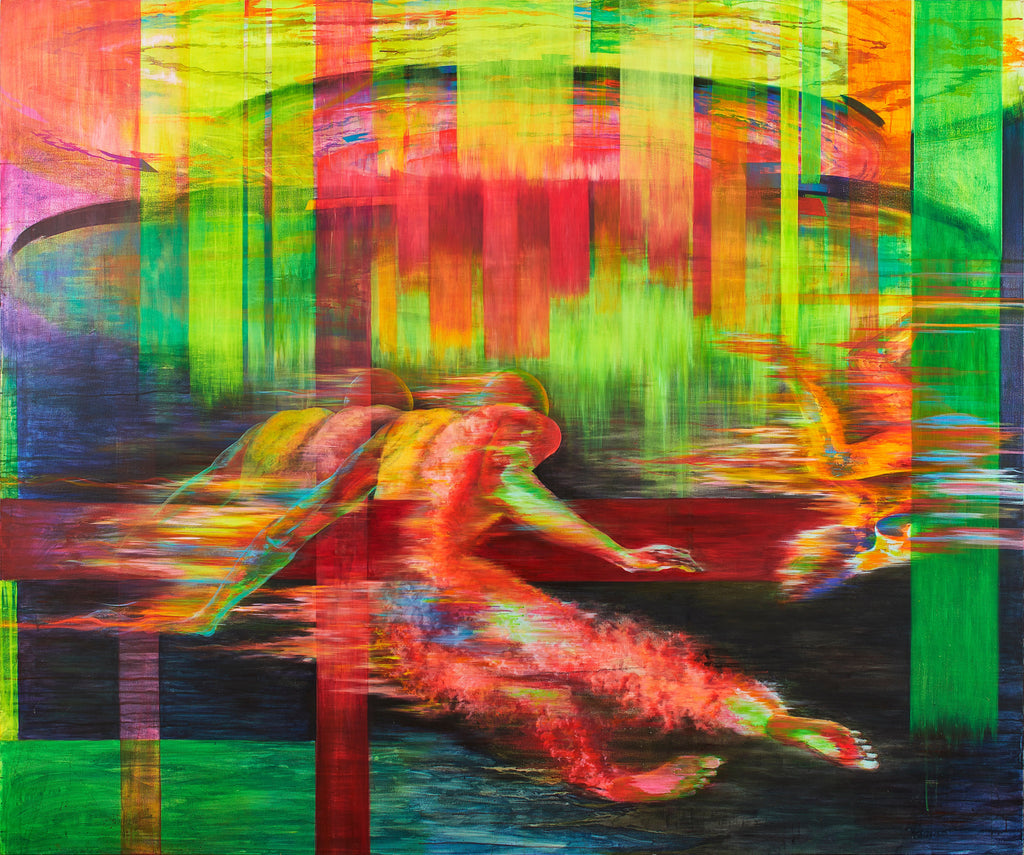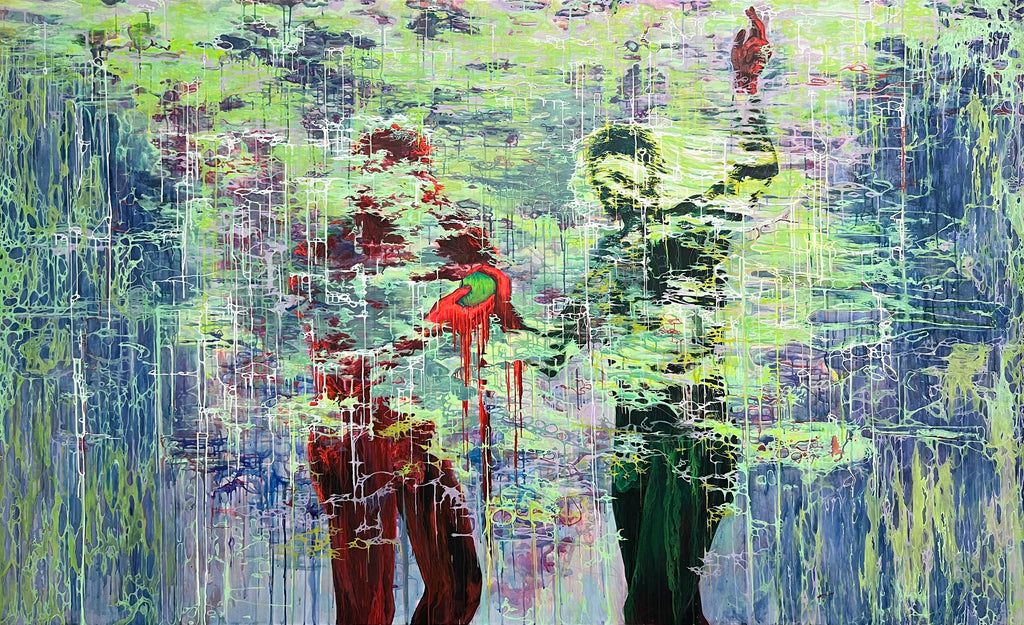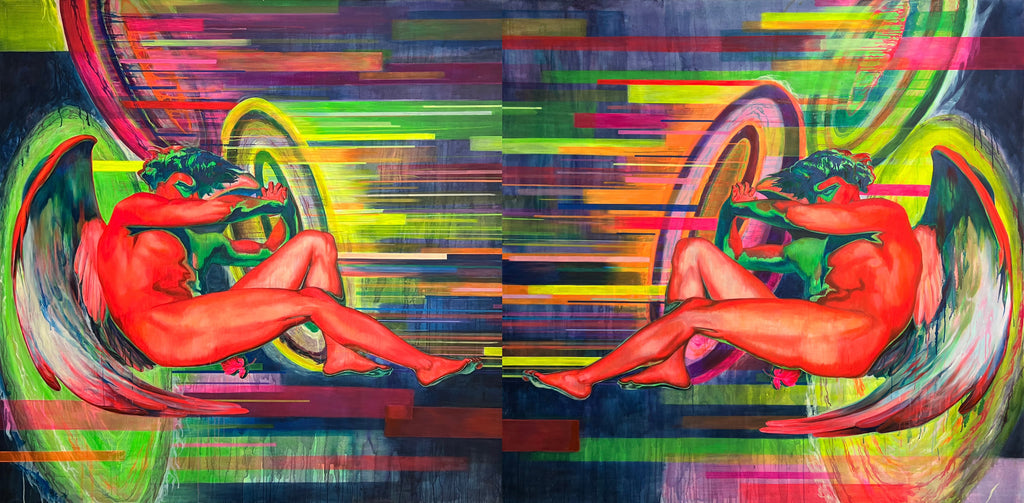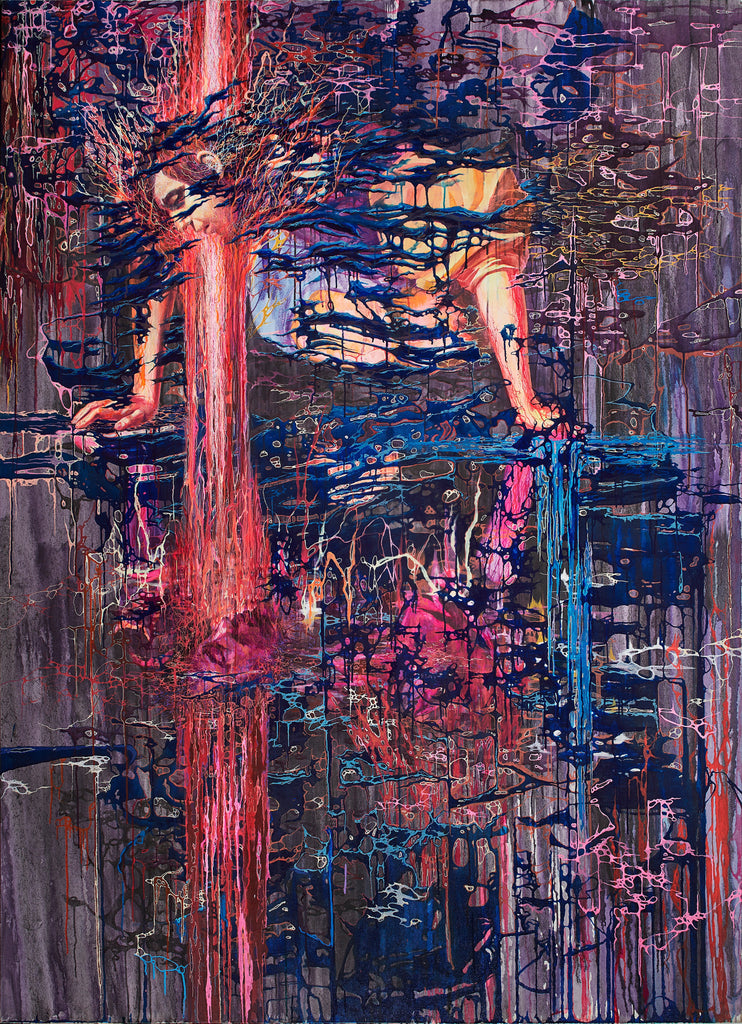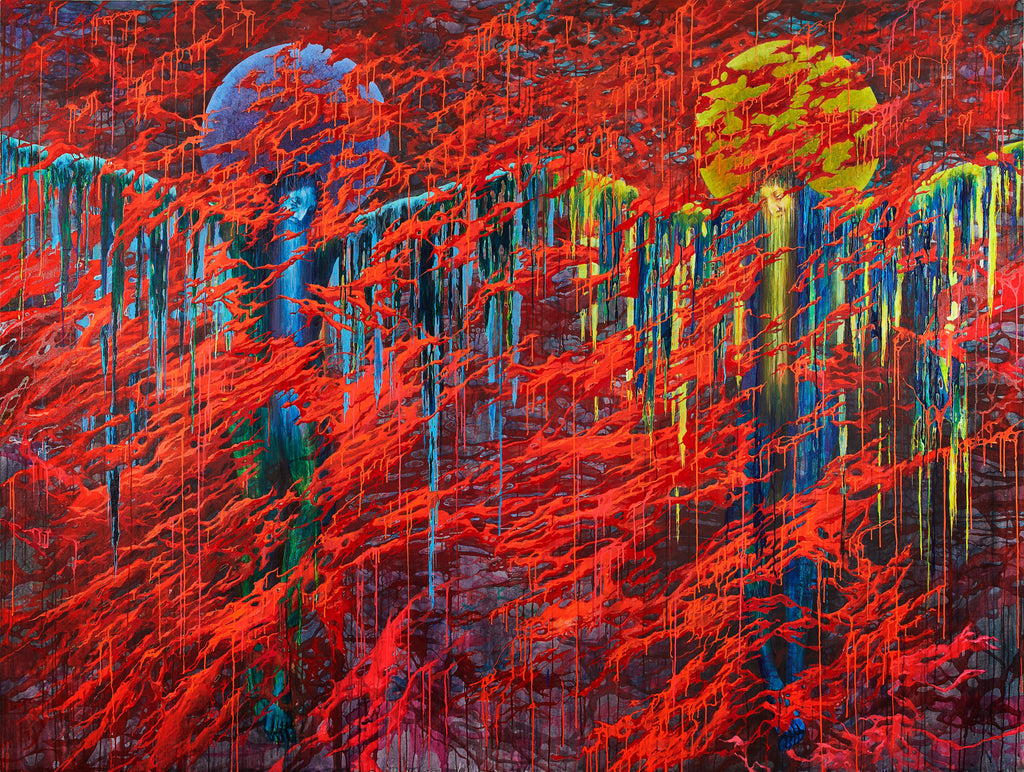ARTICLES
Chi Peng: Unveiling Identity Through Shifting Forms
2024.10.15
INTERVIEW

Chi Peng, a renowned artist who has been active on the global art stage since his twenties, recently held his latest solo exhibition, ON & ON OFF & OFF, at Whitestone Gallery Beijing. This exhibition marks his first formal presentation of painting, continuing his exploration of the duality of identity and the complexity of self-representation, themes central to his photographic work.
This interview was initially published by ArtAlpha, offering an in-depth interpretation of Chi Peng’s transition from photography to painting and the unique thought process behind his artistic creation.
In Conversation with Chi Peng: Sincerity and Sensitivity—A Double-Edged Sword

Chi Peng
Chi Peng gained fame at an early age. He graduated from the Central Academy of Fine Arts (CAFA) and, between the ages of 23 and 30, was deeply committed to expressing himself through photography, achieving remarkable success for someone of his age.
In 2005, just after graduating, he held his first solo exhibition in New York, which drew international attention. Since then, he has held solo exhibitions in dozens of countries, and more than 100 of his works have been collected by international art institutions.
In 2011, the Groninger Museum, Groningen, Netherlands, hosted a large-scale exhibition of Chi Peng's work titled “Me, Myself, and I, Photoworks 2003-2010”. This was the first time the museum held a solo exhibition for an artist under 30.
However, as these accolades accumulated on a young artist, Chi Peng gradually experienced a period of fear and anxiety.
Driven by the desire to create work of true value, Chi Peng "shamelessly" returned to the Central Academy of Fine Arts (CAFA) to become a teacher.
During his years of teaching at the School of Design of the Central Academy of Fine Arts, he became one of the most popular professors. Wherever he went, he was always surrounded by students, and his lectures often attracted many students from outside his class. Answering questions from both familiar and unfamiliar students became a daily routine for him during those years.
At the same time, Chi Peng also took on another role as a children's art educator. He researched art education methods for children and published several instructional picture books.
Despite juggling these roles, Chi Peng still felt something was missing. He had yet to fulfill his dream of making a film. After completing the script and securing funding, he shot his first feature film "As water in water" between 2019 and 2021.
After completing the film's editing in 2021, Chi Peng turned around and picked up a paintbrush again. This puzzled many people—despite his deep foundation in photography and his background at a design academy, he had decided to pursue painting.

Chi Peng's Solo Exhibition ON & ON OFF & OFF at Whitestone Gallery Beijing
On September 14, Chi Peng’s latest solo exhibition ON & ON OFF & OFF opened at Whitestone Gallery Beijing, marking the first official exhibition of his paintings, showcasing recent works. This series continues the "twinning" concept seen in his photography, exploring the diversity and complexity of identity.
The works feature clashing, flowing colors, intricate lines, and forms, with the intense desire for expression coexisting with the concealment of the subject’s image. Beneath the bold exterior, something remains blurred and hidden…
During the interview, Chi Peng spoke rapidly, often saying, "This is related to my personality," frequently mentioning his sensitivity, changeability, and perfectionism.
ArtAlpha used the exhibition as an entry point to explore the simple yet complex, rational yet emotional, passionate yet melancholic nature of Chi Peng.
01 I’ve Always Been Expressing Issues Related to Identity
Chi Peng "Buffering", 2022, 194.0 × 234.0 cm, Acrylic on canvas
- People were previously more familiar with your photography works, but this exhibition focuses on painting, offering a completely new image of you. Why did you make the transition to painting?
Chi Peng: I have always been constantly deducing and adjusting my own logic, exploring my potential. My creative direction has always pointed towards the unknown and possibilities of the future, which I consider to be extremely important.
For an artist, it’s unimaginable to lack creativity; for a nation, lacking creativity would be very dangerous. Therefore, in my photography, I was always pursuing a sense of novelty. But after some time, I stopped creating photographic works because I felt that the language of photography was starting to become exhausted.
If one creates simply for the sake of creating, or only to earn money through art, I believe that is unnecessary. Art creation shouldn’t be merely about survival—it should aspire to something higher.
Moreover, the shift from photography to painting was not an impulsive decision for me. During my time teaching at the Central Academy of Fine Arts (CAFA), I taught courses such as Form and Imagination, Materials and Synesthesia, and Reading Images and Narratives. These are fundamental courses for students engaged in artistic creation. These courses led me to continuously study visual methods and made me begin to think: how can I express myself through the study of visual methods? Painting was the first step that came to mind.
Although painting and photography are two different art forms, my pursuit of expression has remained consistent throughout.

Chi Peng's Solo Exhibition ON & ON OFF & OFF at Whitestone Gallery Beijing
- Your photography, including your first feature film from the past two years, and the paintings in this exhibition—how do these artistic forms differ in terms of the themes they express?
Chi Peng: I have always been exploring the concept of the "duality of body," and this theme runs throughout all my artistic forms, no matter the medium.
The main thread of my work is "twinning," that is, the replication of the body in the works. This consistent logic has never changed.
At the same time, I’ve been exploring the relationship between "singleton" and "twin," which is closely related to my experience as an only child born in the 1980s. My film also touches on the theme of only children and tells the story of "loss of an only child."
Another theme I explore is the relationship between the individual and the collective. This creative thread has deep roots in the experience of those born in the 1980s.

Chi Peng's Solo Exhibition ON & ON OFF & OFF at Whitestone Gallery Beijing
- It seems that your photography often reflects groups of people, whereas in this series of paintings, the concept of "twinning" is emphasized more. Why is that?
Chi Peng: Replicating a large number of figures doesn’t hold much significance in painting itself. In painting, I prefer to emphasize the sense of loneliness between two individuals. In fact, this sense of loneliness stems more from the introspection that comes with age and a personality that becomes more inward.
These two individuals actually represent a form of "separation" within oneself—a kind of internal contradiction and dialogue. This expression seeks to explore the deep inner self, where loneliness and opposition coexist in personal communication.

Chi Peng "Firework" Artwork’s Close-up
- The characters in your works seem to exist in a state of flux. Does this relate to the diversity of your own identity in real life?
Chi Peng: My identity feels overwhelmingly complex at times. When people ask what I do, I often feel like a fraud—it seems impossible for one person to manage so many roles at once. These different identities are not just facets of who I am, but also attempts to fill inner voids, to mend the gaps in my personality.
I stay busy to avoid confronting loneliness and isolation. This busyness is a form of escapism, a way to distance myself from the fears and emotional drift within.
I see a hidden connection between this emotional drift and the diversity of my identities. They resemble two plants, appearing to grow separately yet sharing the same roots. Like air that subtly permeates everything, this connection is invisible on the surface but deeply intertwined beneath.
Lately, I’ve been reflecting on the role art should play and the value of its expression. I believe an artist doesn’t need to provoke through subject matter alone but can challenge boundaries and innovate through form. In my work, I always strive to push the limits of artistic language, exploring new expressions that allow the art itself to reveal its sharpness.
02 Using a Designer’s Mindset to Open Up New Approaches to Painting

Chi Peng's Solo Exhibition ON & ON OFF & OFF at Whitestone Gallery Beijing
- What is the meaning behind the title of the exhibition, ON & ON OFF & OFF?
Chi Peng: ON & ON OFF & OFF refers to how the freedom of thought brings boundless possibilities to painting. The beauty of painting lies in its combination of technique and thought, creating a rich variety of forms of expression.
The "upper limit" represents the infinite possibilities of breaking boundaries, while the "lower limit" refers to holding onto the fundamental principles of expressing the world. As the saying goes, without rules, nothing can be accomplished.
I dislike when art emphasizes freedom to the point of losing structure, as it often leads to an unruly and scattered approach. Freedom does not equate to disorder, and we often see that expressions in art, when too focused on freedom, end up looking very unrefined.
Chi Peng "It's not Just Their Fault", 2022, 172.0x280.0cm, Acrylic on canvas
- As a graduate of the School of Design of the Central Academy of Fine Arts (CAFA), now working in painting, how do you view the relationship between design and painting?
Chi Peng: To me, the relationship between them boils down to the question of whether "consciousness comes first" or "language comes first," which translates to "what to paint" versus "how to paint."
We often think that what to paint doesn’t matter much, but in fact, it is far more important. What you choose to paint determines the artist’s stance, while how you paint it defines the artist’s aesthetic direction.
One of the shortcomings in contemporary Chinese painting is the issue of what to paint. Most people only express a vague intention, without a clear theme. As for how to paint, the independence of the language is very important.
The designer’s mindset is highly conducive to introducing new ways of thinking. Design is closer to the modern world, and using the thinking and logic behind design can help open up the mind in painting. However, it is still up to the artist to complete the final result.

Chi Peng's Solo Exhibition ON & ON OFF & OFF at Whitestone Gallery Beijing
- Although your background is in design, you have excellent skills in form and control over large-scale compositions. How do you achieve that?
Chi Peng: If someone trained in "studies of modeling" were to critique my work, I might not pass their standards. However, I believe that the more technical skill you have, the more limited your painting can become.
It’s sad when one cannot let go of past glories. Sometimes, certain techniques must be abandoned. I believe that a strong person should not always dwell on their past, but rather focus on the future. I have never cherished what I already possess; instead, I am always pondering what I don’t have. However, constantly challenging oneself is indeed a difficult task.
Chi Peng "Lucifer's Mirror", 2023, 205.0x410.0cm, Acrylic on canvas
- The sense of suspension in the figures within your paintings gives off a feeling of unease.
Chi Peng: My PhD dissertation explored the sense of suspension in contemporary imagery, and this is also a topic I teach in my classes. My paintings reflect this same idea.
Suspension is, essentially, about uncertainty, and I believe that uncertainty is a very good thing. There’s so much that can be explored within it.
"Lucifer's Mirror" Artwork’s Close-up
- Many of your works involve elements of Western art, such as the influence of Caravaggio or the depiction of the angel in Lucifer’s Mirror. How did you approach these elements?
Chi Peng: This piece portrays the moment when the angel Gabriel transforms between good and evil. After a particular gaze, he turns evil. The painting captures that critical juncture between good and evil. In reality, human nature is always in flux, constantly wavering between these two choices.
03 Poisoning and Curing Myself at the Same Time

Chi Peng's Solo Exhibition ON & ON OFF & OFF at Whitestone Gallery Beijing
- What is your painting process like?
Chi Peng: Throughout the entire painting process, I am always filled with anxiety, both terrified and uncertain. I never feel confident enough to say that I have complete control over my painting. It’s impossible to be fully at ease during creation—every step requires constant experimentation.
My personality ensures that I’m always critical of myself. I’m an extremely self-reflective person, and this characteristic shapes my approach to everything I do.
When I undertake anything, I might appear calm on the surface, but internally, I’m often filled with anxiety and unease. Most people probably can’t understand the depth of my anxiety.

Chi Peng's Solo Exhibition ON & ON OFF & OFF at Whitestone Gallery Beijing
- Do you think anxiety is a common trait among artists?
Chi Peng: My sensitivity and emotional delicacy have reached an extreme level. I often rely on another aspect of my personality to keep myself balanced and push through the inner conflicts. I’ve never met anyone more sensitive than myself, and people with my type of personality are easily prone to depression.
Emotional fluctuations are normal when you’re young, but it’s quite rare to maintain this level of sensitivity and delicacy into your 40s.
I often feel like I’m poisoning myself while simultaneously curing myself, and I keep repeating this process—that’s just who I am. My creations are highly consistent, and the duality of self and anxiety in my work is a true reflection of my inner state. Each painting has its own roots and internal logic.
- In your works, there’s a recurring theme of intertwined and flowing colors, and the characters seem to gradually disappear. Many of your pieces contain this kind of imagery.
Chi Peng: The intertwined and flowing colors represent ambiguity, reflecting the density and stickiness of my personality. This is who I am—I’m not the flamboyant, intense, or passionate type. I tend more towards being introverted and dissolving rather than expressing with grand gestures. So, the feeling conveyed in my paintings is inherently connected to my personality. I’m the type of person who never feels completely confident or over-expressive.
Chi Peng "A Narcissist's reflection for today", 2023, 220.0x160.0cm, Acrylic on canvas
- How did you develop the language in your paintings?
Chi Peng: For example, in the piece A Narcissist's Reflection for Today featured in the exhibition, it’s so much like me. The language and colors match my personality, and the content is derived from Caravaggio’s Narcissus, depicting a self-obsessed figure in dialogue with their own reflection.
Extremely sensitive people are the ones who are willing to go deeper—to disappear, escape, or hide, seeking out their own flaws. These are the characteristics of people like that, and the language in my paintings completely aligns with this type of personality.
If you visit my studio, you’ll understand why there is a sense of intertwining and overlapping in my works. My studio is packed full of things, messy and cluttered. Only people who lack a sense of security have such habits. I can only feel comfortable in a space like that. I can’t stay in an empty, sterile, and brightly lit place.
- So your works are a very authentic reflection of who you are?
Chi Peng: I approach everything I do with sincerity because it’s in my nature. I push myself to live openly, and this is extremely important to me. The foundation of a person’s integrity comes from the standards they set for themselves and their own self-discipline.
I often think of a quote from the director Terrence Malick’s film A Hidden Life. He said, "God doesn't care what you say, only what's in your heart!" This is similar to concepts in Chinese religion—the key is having good thoughts. It’s not about what you say or the outward actions you take, but the truth of what’s in your heart that matters. If you harbor evil thoughts, no matter how good your words and actions may appear, it’s meaningless. That’s why I’ve always used this idea to keep myself in check.
This is why I am especially suited to being a teacher. I truly want to be a good teacher from the bottom of my heart, dedicating all my energy and passion to it, striving to do my very best and be a teacher who gives it all.
Chi Peng "Who Decides?", 2023, 200.0x270.0cm, Acrylic on canvas
- Your personality seems to make people trust you, whether it’s investors willing to fund your films or students who admire you. Although sincerity and sensitivity can be uncomfortable, do you think they have helped you succeed in some way?
Chi Peng: When I was in my 20s, I said something that still holds true for me today: "A lifetime of difficulty comes from the combination of sincerity and sensitivity. Sincerity is not wrong, and neither is sensitivity, but being both sincere and sensitive is a deadly trap."
As my paintings express, I have always felt like I’m two people—one desperately fantasizing in childhood, and the other fighting to grow up in reality.

Chi Peng's Solo Exhibition ON & ON OFF & OFF at Whitestone Gallery Beijing
*The Simplified Chinese quoted directly from "ArtAlpha" magazine; translations by Whitestone Gallery.
View and purchase Tianjin Ren's artwork online by clicking the link below.
